Reductions in Labor Capacity from Intensified Heat Stress in China under Future Climate Change
Abstract
1. Introduction
2. Materials and Methods
2.1. Climatic Data
2.2. Wet-Bulb Globe Temperature (WBGT)
2.3. Labor Capacity
2.4. Spatial and Temporal Analysis
3. Results
3.1. The Changes in the WBGT
3.2. The Spatial Patterns of the Future Labor Capacity
3.3. The Temporal Changes in the Labor Capacity in the Future
4. Discussion
5. Conclusions
Funding
Acknowledgments
Conflicts of Interest
References
- Liu, X.; Tang, Q.; Liu, W.; Yang, H.; Groisman, P.Y.; Leng, G.; Ciais, P.; Zhang, X.; Sun, S. The asymmetric impact of abundant preceding rainfall on heat stress in low latitudes. Environ. Res. Lett. 2019, 14, 044010. [Google Scholar] [CrossRef]
- Smoyer-Tomic, K.E.; Kuhn, R.; Hudson, A. Heat Wave Hazards: An Overview of Heat Wave Impacts in Canada. Nat. Hazards 2003, 28, 465–486. [Google Scholar] [CrossRef]
- Solymosi, N.; Torma, C.S.; Kern, A.; Marotiagots, A.; Barcza, Z.; Konyves, L.; Berke, O.; Reiczigel, J. Changing climate in Hungary and trends in the annual number of heat stress days. Int. J. Biometeorol. 2010, 54, 423–431. [Google Scholar] [CrossRef] [PubMed]
- Barriopedro, D.; Fischer, E.M.; Luterbacher, J.; Trigo, R.M.; García-Herrera, R. The Hot Summer of 2010: Redrawing the Temperature Record Map of Europe. Science 2011, 332, 220–224. [Google Scholar] [CrossRef]
- Im, E.-S.; Pal, J.S.; Eltahir, E.A.B. Deadly heat waves projected in the densely populated agricultural regions of South Asia. Sci. Adv. 2017, 3, e1603322. [Google Scholar] [CrossRef]
- Sun, Y.; Zhang, X.; Zwiers, F.W.; Song, L.; Wan, H.; Hu, T.; Yin, H.; Ren, G. Rapid increase in the risk of extreme summer heat in Eastern China. Nat. Clim. Chang. 2014, 4, 1082–1085. [Google Scholar] [CrossRef]
- Liu, X.; Tang, Q.; Zhang, X.; Sun, S. Projected changes in extreme high temperature and heat stress in China. J. Meteorol. Res. 2018, 32, 351–366. [Google Scholar] [CrossRef]
- Qian, Z.; He, Q.; Lin, H.M.; Kong, L.; Bentley, C.M.; Liu, W.; Zhou, D. High temperatures enhanced acute mortality effects of ambient particle pollution in the “oven” city of Wuhan, China. Environ. Health Perspect. 2008, 116, 1172–1178. [Google Scholar] [CrossRef]
- Li, Y.; Cheng, Y.; Cui, G.; Peng, C.; Xu, Y.; Wang, Y.; Liu, Y.; Liu, J.; Li, C.; Wu, Z.; et al. Association between high temperature and mortality in metropolitan areas of four cities in various climatic zones in China: A time-series study. Environ. Health 2014, 13, 65. [Google Scholar] [CrossRef]
- Huang, W.; Kan, H.; Kovats, S. The impact of the 2003 heat wave on mortality in Shanghai, China. Sci. Total Environ. 2010, 408, 2418–2420. [Google Scholar] [CrossRef]
- Liu, X.; Tang, Q.; Zhang, X.; Groisman, P.; Sun, S.; Lu, H.; Li, Z. Spatially distinct effects of preceding precipitation on heat stress over eastern China. Environ. Res. Lett. 2017, 12, 115010. [Google Scholar] [CrossRef]
- Wehner, M.; Stone, D.; Krishnan, H.; AchutaRao, K.; Castillo, F. The Deadly Combination of Heat and Humidity in India and Pakistan in Summer 2015. Bull. Am. Meteorol. Soc. 2016, 97, S81–S86. [Google Scholar] [CrossRef]
- Li, J.; Chen, Y.D.; Gan, T.Y.; Lau, N.-C. Elevated increases in human-perceived temperature under climate warming. Nat. Clim. Chang. 2018, 8, 43–47. [Google Scholar] [CrossRef]
- Matthews, T. Humid heat and climate change. Prog. Phys. Geogr. Earth Environ. 2018, 42, 391–405. [Google Scholar] [CrossRef]
- Sherwood, S.C.; Huber, M. An adaptability limit to climate change due to heat stress. Proc. Natl. Acad. Sci. USA 2010, 107, 9552–9555. [Google Scholar] [CrossRef]
- Budd, G.M. Wet-bulb globe temperature (WBGT)—Its history and its limitations. J. Sci. Med. Sport 2008, 11, 20–32. [Google Scholar] [CrossRef]
- Mora, C.; Dousset, B.; Caldwell, I.R.; Powell, F.E.; Geronimo, R.C.; Bielecki, C.R.; Counsell, C.W.W.; Dietrich, B.S.; Johnston, E.T.; Louis, L.V.; et al. Global risk of deadly heat. Nat. Clim. Chang. 2017, 7, 501. [Google Scholar] [CrossRef]
- Kang, S.; Eltahir, E.A.B. North China Plain threatened by deadly heatwaves due to climate change and irrigation. Nat. Commun. 2018, 9, 2894. [Google Scholar] [CrossRef]
- Pal, J.S.; Eltahir, E.A.B. Future temperature in southwest Asia projected to exceed a threshold for human adaptability. Nat. Clim. Chang. 2015, 6, 197. [Google Scholar] [CrossRef]
- Xia, Y.; Li, Y.; Guan, D.; Tinoco, D.M.; Xia, J.; Yan, Z.; Yang, J.; Liu, Q.; Huo, H. Assessment of the economic impacts of heat waves: A case study of Nanjing, China. J. Clean. Prod. 2018, 171, 811–819. [Google Scholar] [CrossRef]
- Yu, S.; Xia, J.; Yan, Z.; Zhang, A.; Xia, Y.; Guan, D.; Han, J.; Wang, J.; Chen, L.; Liu, Y. Loss of work productivity in a warming world: Differences between developed and developing countries. J. Clean. Prod. 2019, 208, 1219–1225. [Google Scholar] [CrossRef]
- Li, X.; Chow, K.H.; Zhu, Y.; Lin, Y. Evaluating the impacts of high-temperature outdoor working environments on construction labor productivity in China: A case study of rebar workers. Build. Environ. 2016, 95, 42–52. [Google Scholar] [CrossRef]
- Zander, K.K.; Botzen, W.J.W.; Oppermann, E.; Kjellstrom, T.; Garnett, S.T. Heat stress causes substantial labour productivity loss in Australia. Nat. Clim. Chang. 2015, 5, 647–651. [Google Scholar] [CrossRef]
- Zhao, Y.; Sultan, B.; Vautard, R.; Braconnot, P.; Wang, H.J.; Ducharne, A. Potential escalation of heat-related working costs with climate and socioeconomic changes in China. Proc. Natl. Acad. Sci. USA 2016, 113, 4640–4645. [Google Scholar] [CrossRef] [PubMed]
- Kjellstrom, T.; Lemke, B.; Otto, M. Mapping Occupational Heat Exposure and Effects in South-East Asia: Ongoing Time Trends 1980–2011 and Future Estimates to 2050. Ind. Health 2013, 51, 56–67. [Google Scholar] [CrossRef] [PubMed]
- Kjellstrom, T.; Freyberg, C.; Lemke, B.; Otto, M.; Briggs, D. Estimating population heat exposure and impacts on working people in conjunction with climate change. Int. J. Biometeorol. 2018, 62, 291–306. [Google Scholar] [CrossRef] [PubMed]
- Lee, S.-W.; Lee, K.; Lim, B. Effects of climate change-related heat stress on labor productivity in South Korea. Int. J. Biometeorol. 2018, 62, 2119–2129. [Google Scholar] [CrossRef] [PubMed]
- Sheridan, S.C.; Allen, M.J. Temporal trends in human vulnerability to excessive heat. Environ. Res. Lett. 2018, 13, 043001. [Google Scholar] [CrossRef]
- Dunne, J.P.; Stouffer, R.J.; John, J.G. Reductions in labour capacity from heat stress under climate warming. Nat. Clim. Chang. 2013, 3, 563–566. [Google Scholar] [CrossRef]
- Weedon, G.P.; Gomes, S.; Viterbo, P.; Shuttleworth, W.J.; Blyth, E.; Österle, H.; Adam, J.C.; Bellouin, N.; Boucher, O.; Best, M. Creation of the WATCH Forcing Data and Its Use to Assess Global and Regional Reference Crop Evaporation over Land during the Twentieth Century. J. Hydrometeorol. 2011, 12, 823–848. [Google Scholar] [CrossRef]
- Hempel, S.; Frieler, K.; Warszawski, L.; Schewe, J.; Piontek, F. A trend-preserving bias correction—The ISI-MIP approach. Earth Syst. Dyn. 2013, 4, 219–236. [Google Scholar] [CrossRef]
- Schewe, J.; Heinke, J.; Gerten, D.; Haddeland, I.; Arnell, N.W.; Clark, D.B.; Dankers, R.; Eisner, S.; Fekete, B.M.; Colon-Gonzalez, F.J.; et al. Multimodel assessment of water scarcity under climate change. Proc. Natl. Acad. Sci. USA 2014, 111, 3245–3250. [Google Scholar] [CrossRef] [PubMed]
- Davie, J.C.S.; Falloon, P.D.; Kahana, R.; Dankers, R.; Betts, R.; Portmann, F.T.; Wisser, D.; Clark, D.B.; Ito, A.; Masaki, Y.; et al. Comparing projections of future changes in runoff from hydrological and biome models in ISI-MIP. Earth Syst. Dyn. 2013, 4, 359–374. [Google Scholar] [CrossRef]
- Liu, X.; Tang, Q.; Voisin, N.; Cui, H. Projected impacts of climate change on hydropower potential in China. Hydrol. Earth Syst. Sci. 2016, 20, 3343–3359. [Google Scholar] [CrossRef]
- American College of Sports Medicine (ACSM). Prevention of Thermal Injuries During Distance Running. Phys. Sportsmed. 1984, 12, 43–51. [Google Scholar] [CrossRef]
- Willett, K.M.; Sherwood, S. Exceedance of heat index thresholds for 15 regions under a warming climate using the wet-bulb globe temperature. Int. J. Climatol. 2012, 32, 161–177. [Google Scholar] [CrossRef]
- National Occupational Health Standards Committee. Occupational Exposure Limits for Hazardous Agents in the Workplace Part2: Physical Agents; Ministry of Health of the People’s Republic of China: Beijing, China, 2007; Volume GBZ 2.2-2007.
- McSweeney, C.F.; Jones, R.G. How representative is the spread of climate projections from the 5 CMIP5 GCMs used in ISI-MIP? Clim. Serv. 2016, 1, 24–29. [Google Scholar] [CrossRef]
- Lemke, B.; Kjellstrom, T. Calculating Workplace WBGT from Meteorological Data: A Tool for Climate Change Assessment. Ind. Health 2012, 50, 267–278. [Google Scholar] [CrossRef]
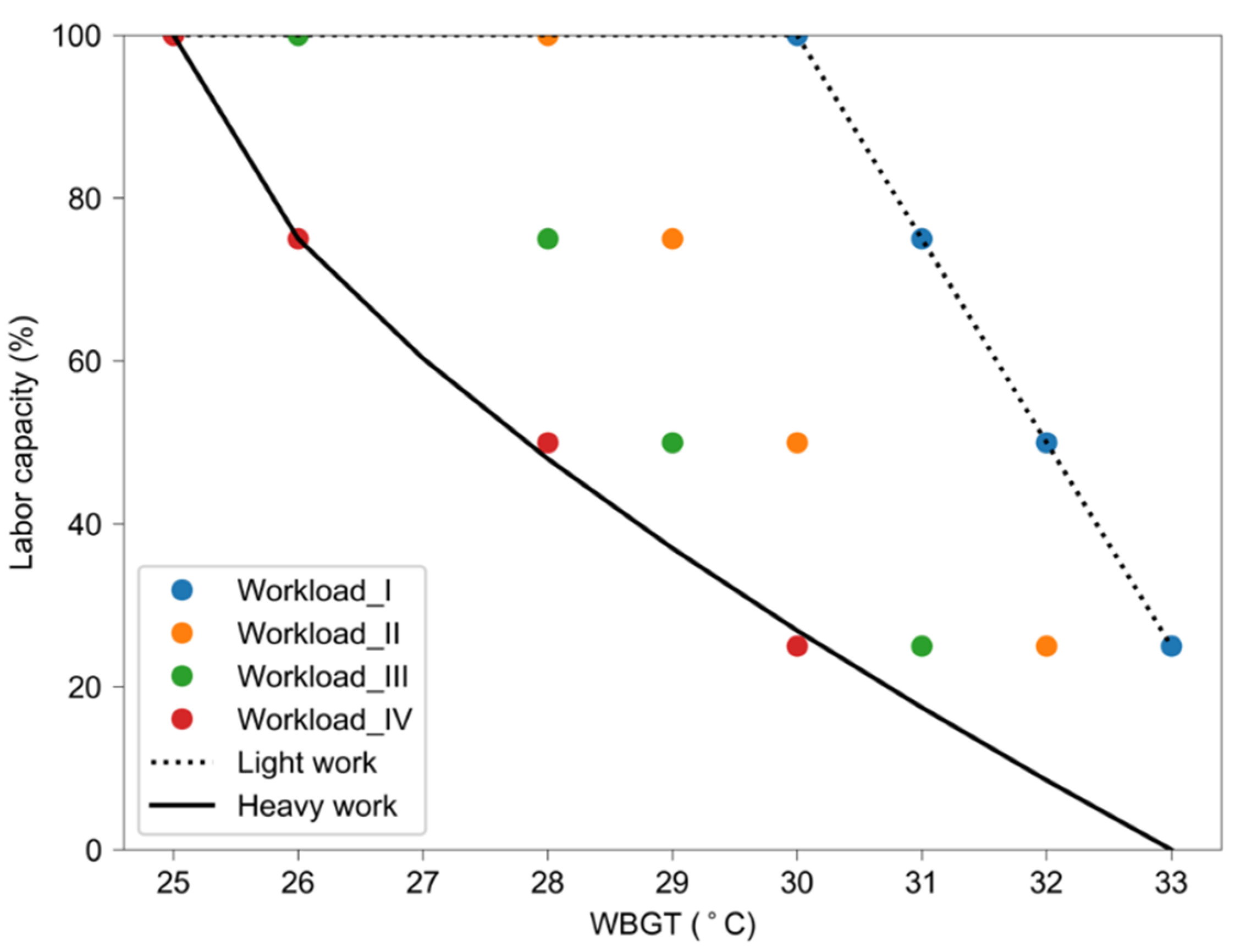
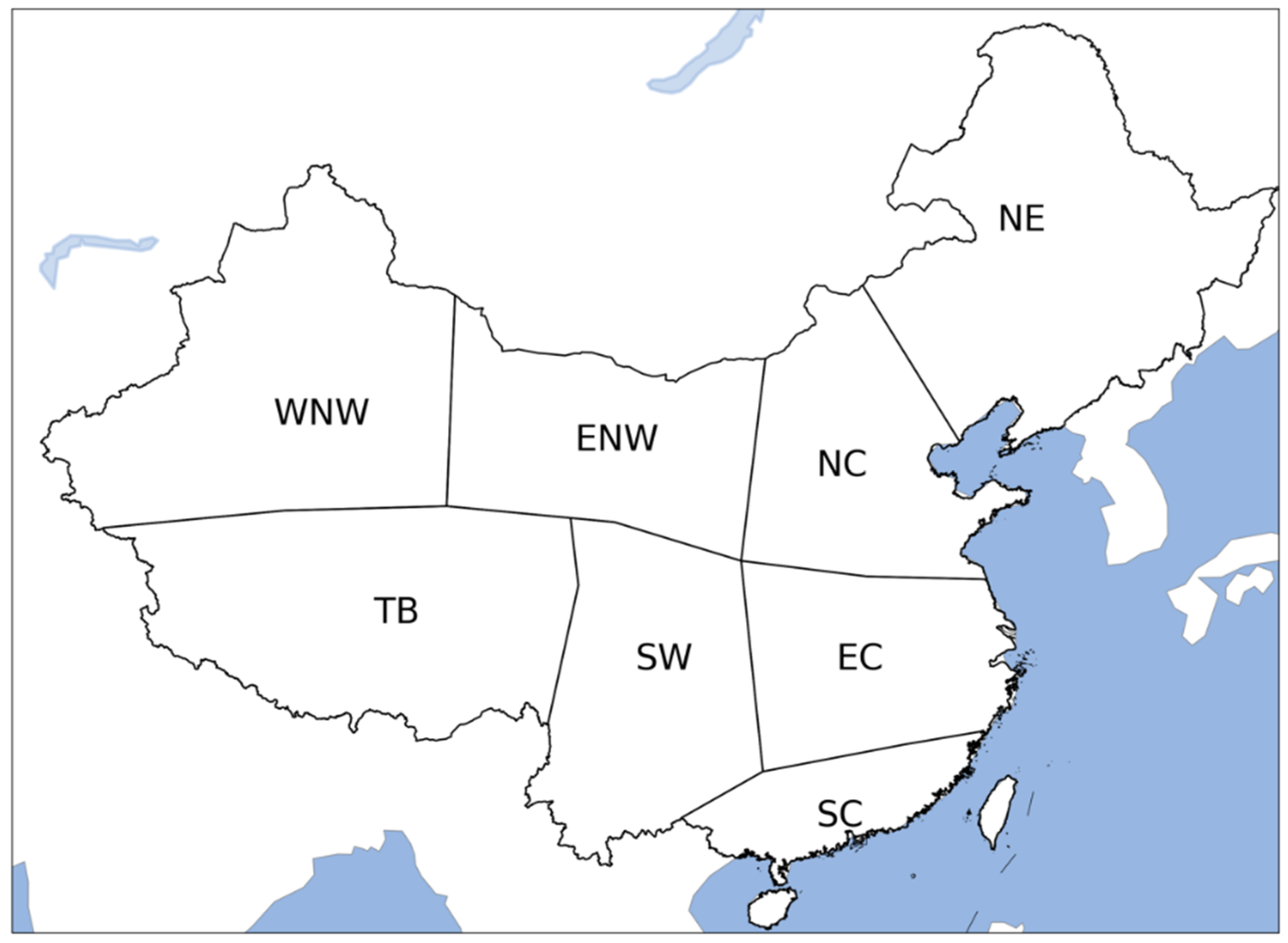
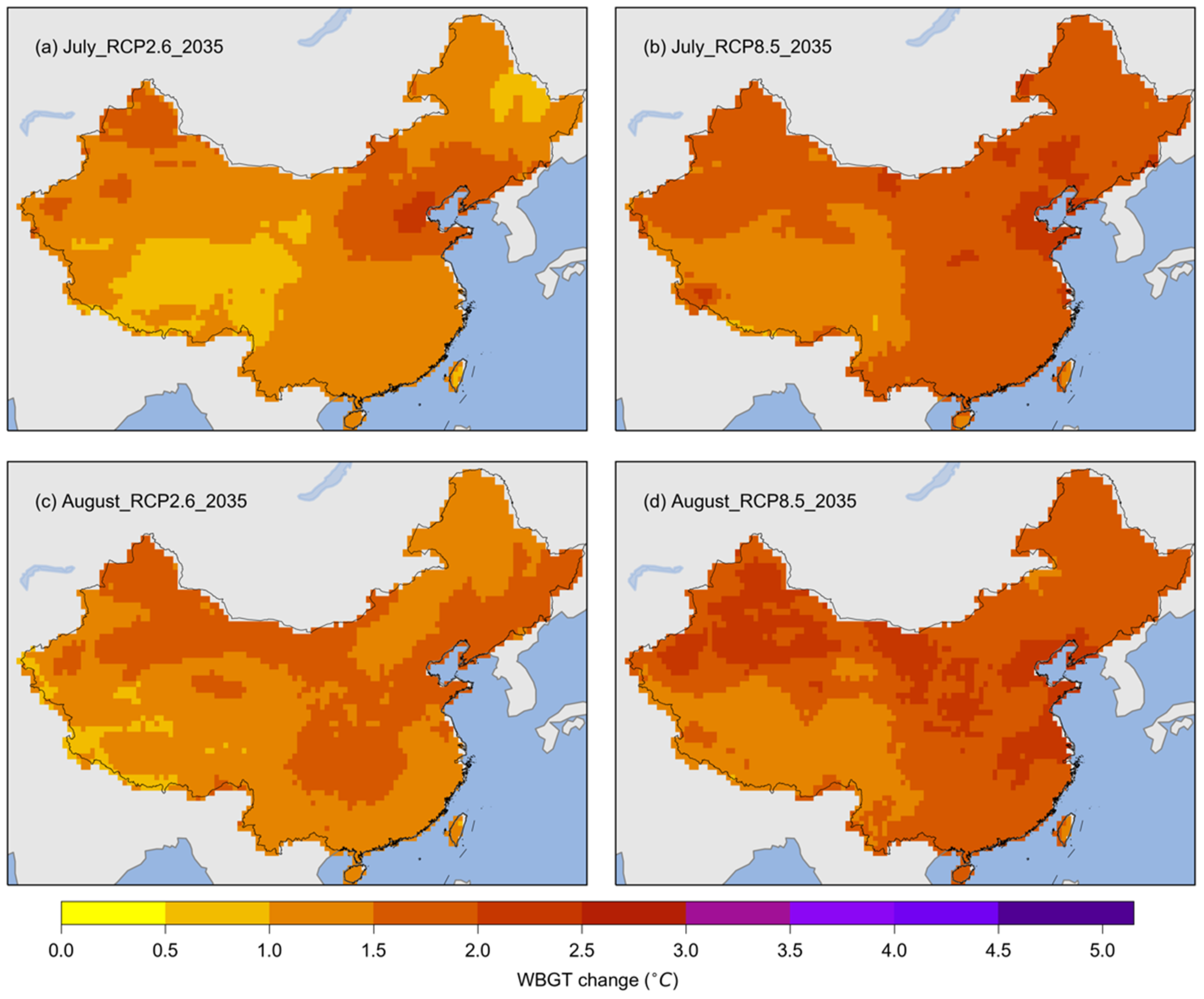

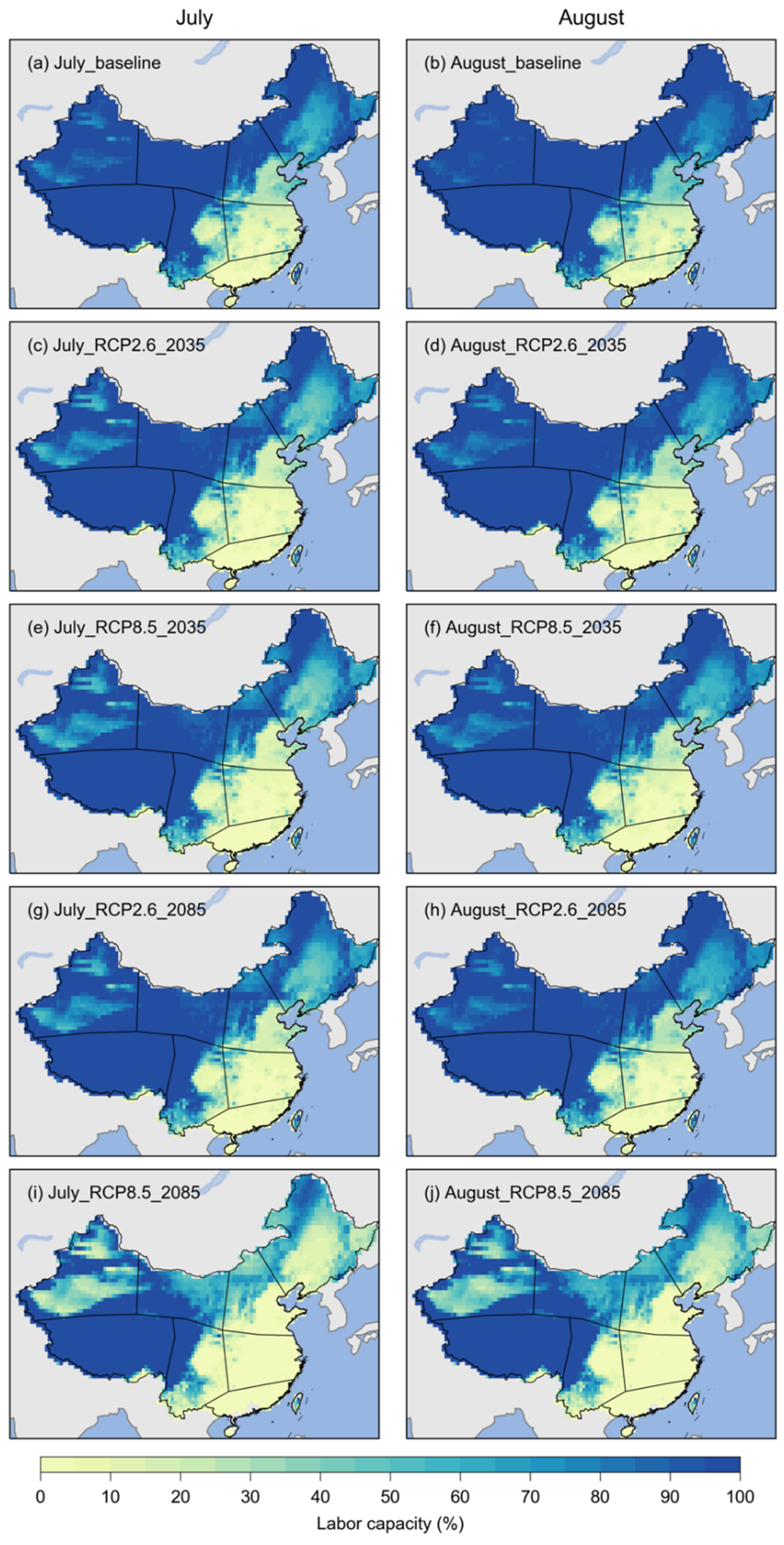
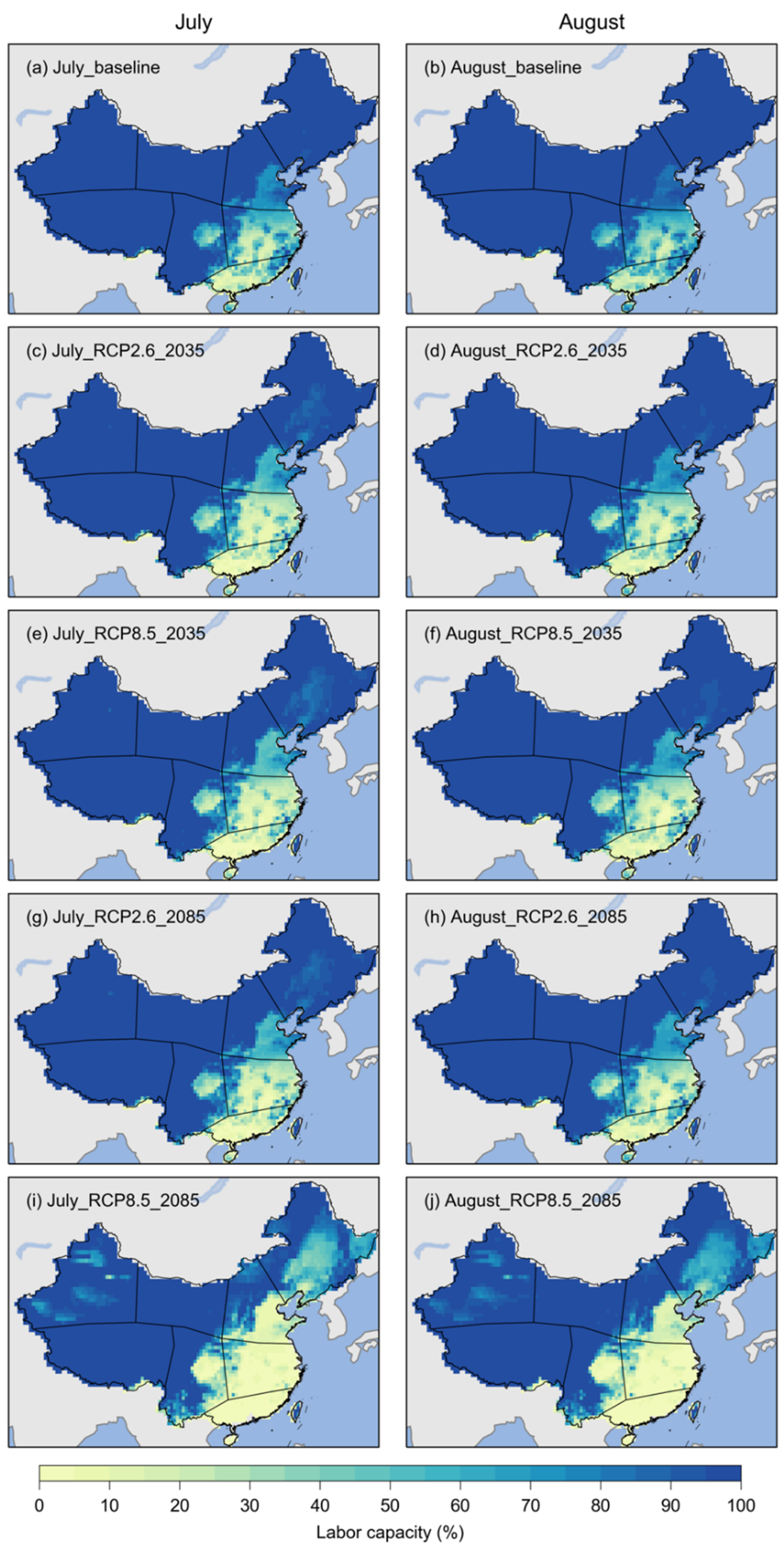
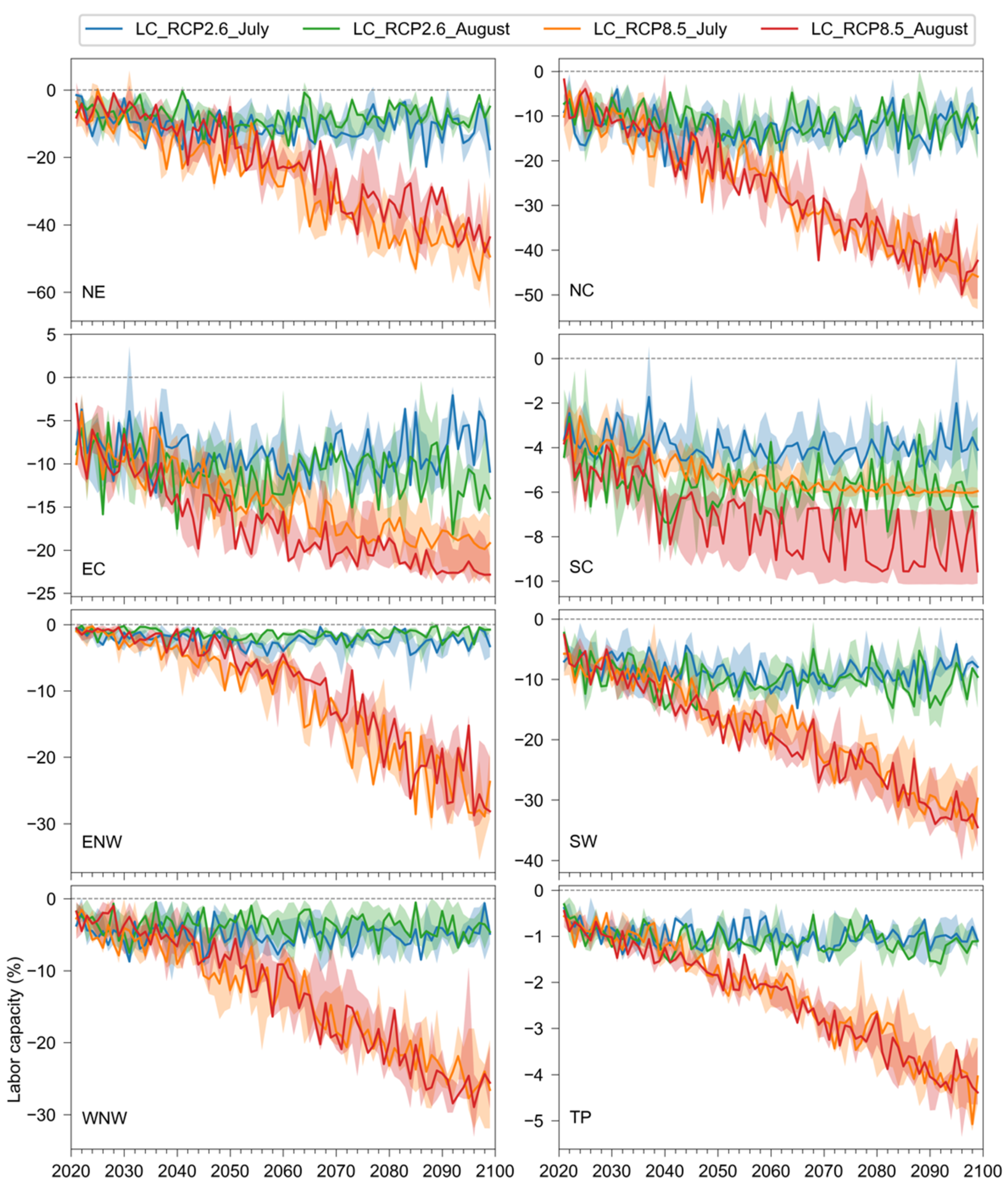

| Labor Capacity (%) | Workload | |||
|---|---|---|---|---|
| I | II | III | IV | |
| 100 | 30 | 28 | 26 | 25 |
| 75 | 31 | 29 | 28 | 26 |
| 50 | 32 | 30 | 29 | 28 |
| 25 | 33 | 32 | 31 | 30 |
| RCP26_July | Baseline | 2035 | 2085 | RCP85_July | Baseline | 2035 | 2085 |
| NE | 85.39 | −6.96 | −9.49 | NE | 85.39 | −12.10 | −42.07 |
| NC | 67.43 | −13.10 | −14.43 | NC | 67.43 | −15.28 | −40.20 |
| EC | 20.10 | −7.39 | −7.18 | EC | 20.10 | −10.76 | −18.29 |
| SC | 6.00 | −3.39 | −3.59 | SC | 6.00 | −4.27 | −5.92 |
| ENW | 99.11 | −2.39 | −2.48 | ENW | 99.11 | −3.49 | −22.01 |
| SW | 64.69 | −7.69 | −9.36 | SW | 64.69 | −11.26 | −29.06 |
| WNW | 95.03 | −4.10 | −4.36 | WNW | 95.03 | −6.57 | −22.39 |
| TP | 93.14 | −0.86 | −0.94 | TP | 93.14 | −1.05 | −3.64 |
| CN | 85.21 | −4.00 | −4.57 | CN | 85.21 | −5.52 | −17.19 |
| RCP26_August | Baseline | 2035 | 2085 | RCP85_August | Baseline | 2035 | 2085 |
| NE | 91.01 | −6.91 | −9.40 | NE | 91.01 | −8.78 | −34.91 |
| NC | 72.88 | −10.76 | −11.87 | NC | 72.88 | −13.73 | −40.04 |
| EC | 24.12 | −10.89 | −12.10 | EC | 24.12 | −11.95 | −21.41 |
| SC | 9.82 | −5.45 | −5.30 | SC | 9.82 | −5.04 | −8.21 |
| ENW | 99.47 | −1.30 | −1.87 | ENW | 99.47 | −2.30 | −19.85 |
| SW | 66.26 | −9.52 | −11.13 | SW | 66.26 | −10.42 | −27.88 |
| WNW | 97.63 | −3.34 | −3.86 | WNW | 97.63 | −5.13 | −23.36 |
| TP | 93.10 | −1.03 | −1.29 | TP | 93.10 | −1.11 | −3.78 |
| CN | 85.67 | −4.23 | −4.57 | CN | 85.67 | −5.55 | −15.82 |
| RCP26_July | Baseline | 2035 | 2085 | RCP85_July | Baseline | 2035 | 2085 |
| NE | 99.47 | −1.46 | −1.30 | NE | 99.47 | −2.79 | −22.14 |
| NC | 92.44 | −7.99 | −10.13 | NC | 92.44 | −10.26 | −35.67 |
| EC | 51.60 | −15.42 | −16.13 | EC | 51.60 | −21.28 | −44.65 |
| SC | 29.72 | −15.18 | −16.98 | SC | 29.72 | −18.81 | −29.36 |
| ENW | 99.99 | −0.05 | −0.04 | ENW | 99.99 | −0.07 | −1.13 |
| SW | 88.24 | −5.24 | −6.59 | SW | 88.24 | −8.22 | −28.39 |
| WNW | 99.94 | −0.17 | −0.21 | WNW | 99.94 | −0.39 | −4.58 |
| TP | 96.14 | −1.03 | −1.10 | TP | 96.14 | −1.18 | −3.66 |
| CN | 95.64 | −2.84 | −3.32 | CN | 95.64 | −4.03 | −15.05 |
| RCP26_August | Baseline | 2035 | 2085 | RCP85_August | Baseline | 2035 | 2085 |
| NE | 99.77 | −0.85 | −1.23 | NE | 99.77 | −1.78 | −17.07 |
| NC | 95.36 | −5.80 | −8.48 | NC | 95.36 | −9.13 | −33.87 |
| EC | 59.38 | −18.11 | −22.53 | EC | 59.38 | −24.07 | −51.19 |
| SC | 36.71 | −21.57 | −21.88 | SC | 36.71 | −21.19 | −30.48 |
| ENW | 100.00 | −0.02 | −0.02 | ENW | 100.00 | −0.03 | −1.05 |
| SW | 89.18 | −7.63 | −8.07 | SW | 89.18 | −8.39 | −27.49 |
| WNW | 99.98 | −0.09 | −0.09 | WNW | 99.98 | −0.14 | −3.47 |
| TP | 96.09 | −1.41 | −.56 | TP | 96.09 | −1.32 | −3.78 |
| CN | 95.78 | −3.24 | −3.67 | CN | 95.78 | −4.46 | −14.82 |
© 2020 by the author. Licensee MDPI, Basel, Switzerland. This article is an open access article distributed under the terms and conditions of the Creative Commons Attribution (CC BY) license (http://creativecommons.org/licenses/by/4.0/).
Share and Cite
Liu, X. Reductions in Labor Capacity from Intensified Heat Stress in China under Future Climate Change. Int. J. Environ. Res. Public Health 2020, 17, 1278. https://doi.org/10.3390/ijerph17041278
Liu X. Reductions in Labor Capacity from Intensified Heat Stress in China under Future Climate Change. International Journal of Environmental Research and Public Health. 2020; 17(4):1278. https://doi.org/10.3390/ijerph17041278
Chicago/Turabian StyleLiu, Xingcai. 2020. "Reductions in Labor Capacity from Intensified Heat Stress in China under Future Climate Change" International Journal of Environmental Research and Public Health 17, no. 4: 1278. https://doi.org/10.3390/ijerph17041278
APA StyleLiu, X. (2020). Reductions in Labor Capacity from Intensified Heat Stress in China under Future Climate Change. International Journal of Environmental Research and Public Health, 17(4), 1278. https://doi.org/10.3390/ijerph17041278





